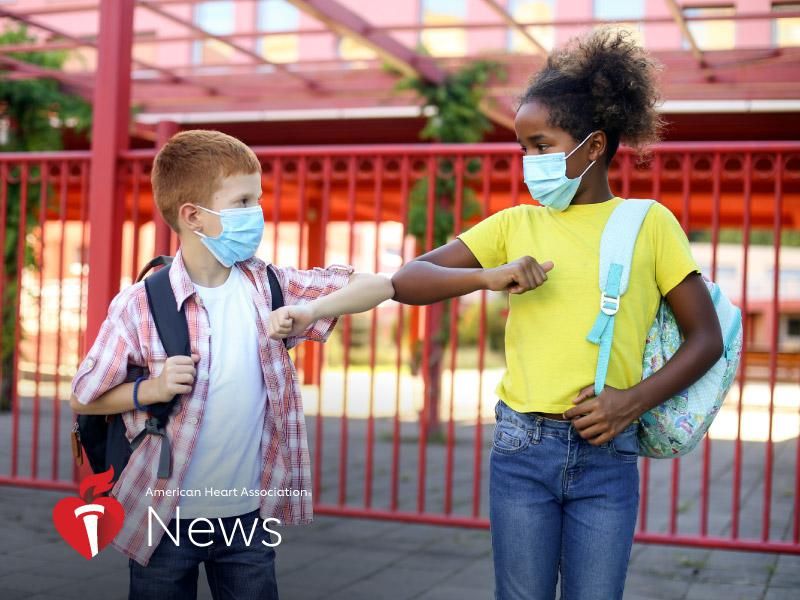TUESDAY, Aug. 3, 2021 (American Heart Association News) — At-home schooling was no vacation for Francis Huang and her 11-year-old daughter, Cheyenne Kuo.
The COVID-19 pandemic thrust remote learning upon their family in spring 2020. With it came the stresses now familiar to millions of families. “I think the whole year, we just tried to survive,” said Huang, who lives in suburban Dallas.
In August, they finally leave all that behind, when Cheyenne starts sixth grade in person. But this year, that means a whole new set of stresses. Cheyenne feels both excitement and worry. “I think I’m half and half.”
Experts say heading back to school will be anything but routine this year. Which means parents and teachers will need to take extra steps to protect children’s mental health.
“There is certainly going to have to be a new way of thinking about everything that goes into the start of a school year,” said Amanda Fitzgerald, assistant deputy executive director of the American School Counselor Association. She co-wrote a guide to re-opening schools that was released last year by her organization and the National Association of School Psychologists.
More than 90% of households with students did some form of remote learning during the pandemic, according to the U.S. Census Bureau. Many students returned to in-person learning last school year, but for those who didn’t, Fitzgerald said, “there’s going to be an adaptation period.”
Consider the 5-year-olds who were in kindergarten when the pandemic hit, said school psychologist Eric Rossen, director of professional development and standards for the National Association of School Psychologists. They might be starting second grade without knowing basic classroom expectations, such as raising their hands before speaking.
Rossen, who also co-wrote the school re-opening guide, said older children have their own challenges.
“Imagine what it was like for students who were in seventh grade,” he said. “They missed their eighth-grade year in middle school, and now they’re entering a high school for the first time. So that transition will not only be extremely significant from the perspective of having been out of a regular routine of school the past year and a half or so, but now they’re entering a brand new building, where they have to reorient themselves.”
On top of all that is the unequal impact of the pandemic. Some families suffered terrible losses and challenges.
“Everybody was affected to some degree, which makes this a universal trauma,” Fitzgerald said. “But everybody still has their own experience.”
Addressing the emotional issues that stem from such factors is essential, she said. “We know that students need to come to school ready to learn. And if they have all of this other stress that they’re dealing with, or in some cases, trauma, it’s going to prevent them from actually learning.”
Stress and trauma can lead to unhealthy behavior and heightened risk of heart disease. Education also has a significant long-term connection to overall health.
So to promote mental wellness, Fitzgerald said, schools and parents will need to adapt.
“There’s going to need to be a little bit more grace and flexibility in terms of ensuring that everybody’s comfortable and confident going to school,” she said. Rossen similarly emphasized the need for “patience, compassion and understanding.”
Schools don’t need to lower standards, he said. But they should avoid overly harsh discipline and be understanding as families re-adapt to a school-day schedule.
The priority should be relationships, Rossen said. “That is, relationships between administrators and staff, between staff and families, between teachers and students, students and peers, all those things.”
Lessons from the pandemic could help, Fitzgerald said. Schools could rethink the traditional model of an “open house” night and instead connect remotely with parents. That, she said, could help identify students who need help coping with the loss of a family member to COVID or a parent’s job loss.
But parents needn’t wait for the schools to come to them, Fitzgerald said. “I’m not saying that everybody needs to be a PTA president, but understand what services are there for your kids if they’re struggling. And ask for help if you need it.”
Heading back to school will be positive for many kids, Rossen said. But kids should know there’s no right or wrong way to feel about it. “It’s OK if you are not looking forward to going back to school. It’s OK if you’re excited. It’s OK if you’re conflicted about it.”
Cheyenne has had all those feelings.
She’s eager to see her school friends in person regularly. She’s also worried about all the new people she’ll encounter at her new middle school.
“It’s kind of, like, exciting,” she said. “At the same time, you’re nervous. But it’ll all be OK at the end.”
Her mother shares her optimism, and some fears.
Huang is worried about what might have been lost academically. She’s also worried about the coronavirus: Cheyenne, who is not old enough for the vaccine, will stay masked but will be interacting with a lot of people. “And I don’t know how many of them have been vaccinated,” Huang said.
But she’s seen her daughter, who was born with a heart defect, overcome challenges before. “What I’m thinking is – the kids are pretty resilient.”
But, Huang said, “I’m pretty sure that the counselors at the school are going to have a lot of work.”
American Heart Association News covers heart and brain health. Not all views expressed in this story reflect the official position of the American Heart Association. Copyright is owned or held by the American Heart Association, Inc., and all rights are reserved. If you have questions or comments about this story, please email editor@heart.org.
By Michael Merschel
Copyright © 2024 HealthDay. All rights reserved.

